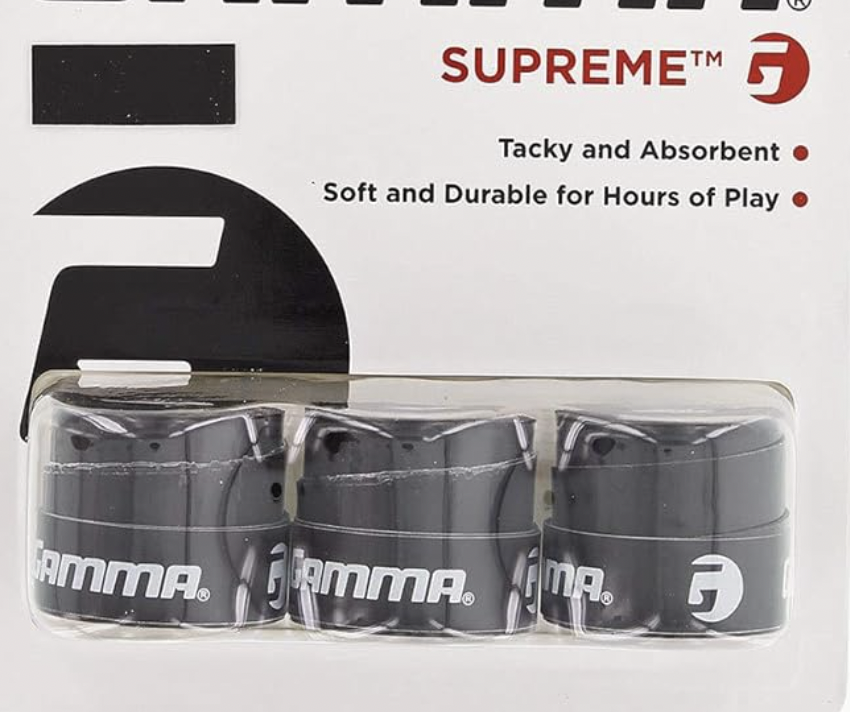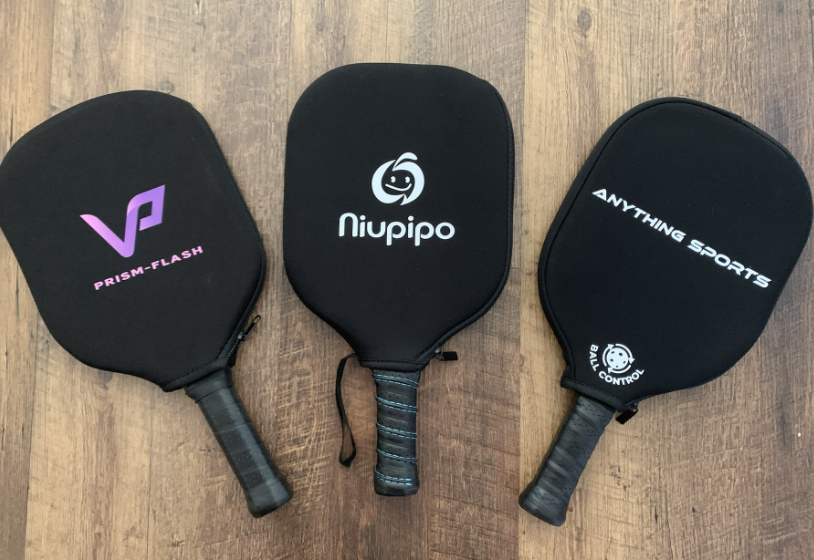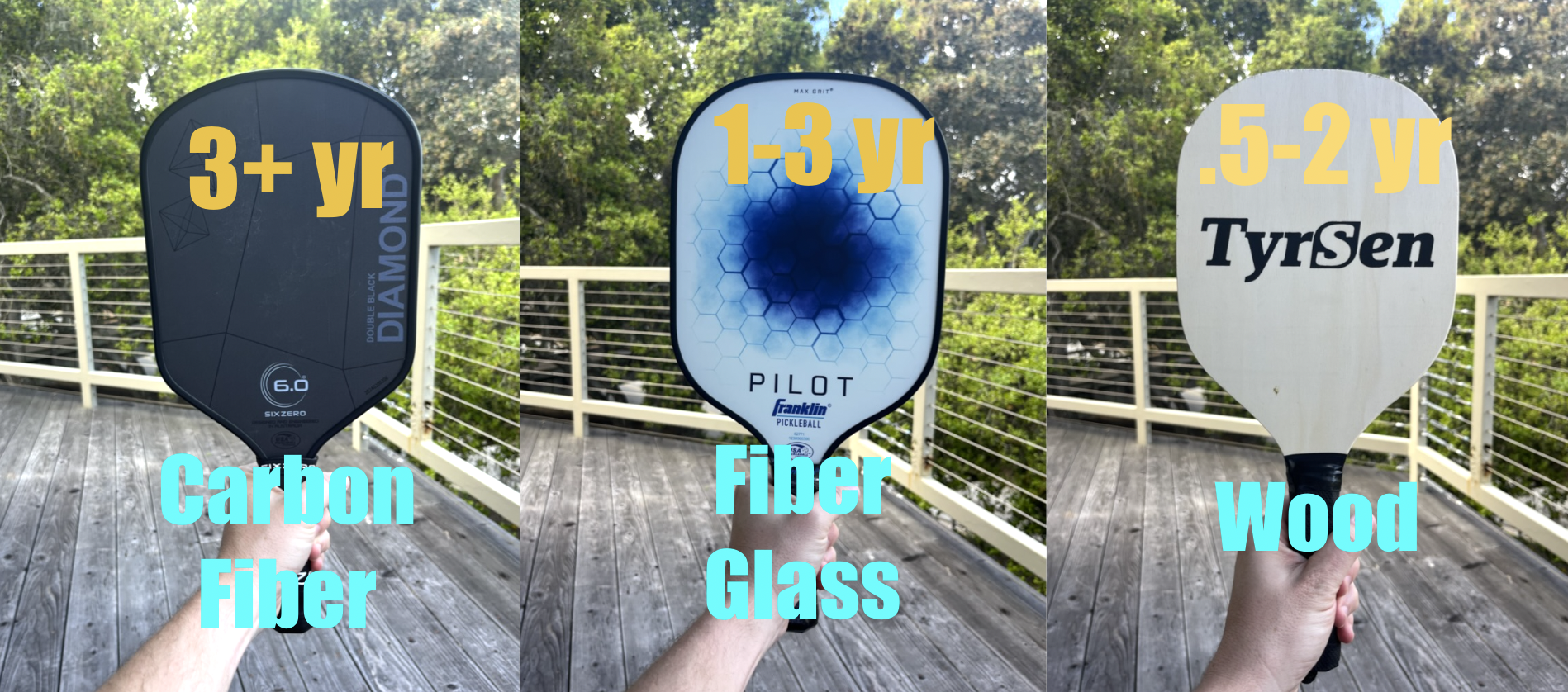I have purchased over 30 pickleball paddles (see receipts), so I would like to say that I understand how long pickleball paddles last.
We will cover how long a paddle can last, paddle material, and how to maintain your paddle to maximize your playing time.
Pickleball paddles will last different amounts of time-based on the material:
- Carbon Fiber: I expect my carbon fiber paddles to last 3+ years with proper care and moderate use.
- Composite: Composite paddles such as carbon fiber will last 1-3 years based on regular play. I’ll cover how to lengthen that time later in this article.
- Wood: I own 4 wooden paddles, and I expect those paddles to last 6 months – 2 years.
It’s important to note that individual experiences may vary, and factors like manufacturing quality and craftsmanship can also influence a paddle’s lifespan.
Next, let me give you a quick primer on the materials.
Understand Pickleball Paddle Materials
We wrote an entire article covering which pickleball paddle material is best for you, so I’d encourage you to check that out, the best beginner paddles and my favorite paddle, in general, are all made from carbon fiber.
- Carbon Fiber: Carbon fiber paddles are gaining popularity for their lightweight yet robust construction. They are highly durable and resistant to dents and scratches, making them a long-lasting choice.
- Composite: Composite paddles, often made from fiberglass or a blend of materials, strike a balance between durability and performance. They can withstand regular play and offer good longevity.
- Wood: Traditional wooden paddles offer a classic feel and are durable but may be prone to wear and tear, especially with heavy use.
Let’s next cover factors that can influence your paddle’s lifespan.
Factors Influencing Paddle Lifespan:
Several factors contribute to how long a pickleball paddle lasts:
- Frequency of Use: The more you play pickleball, the faster your paddle may wear out. Regular players may need to replace their paddles more often than occasional players.
- Intensity of Play: Aggressive players who frequently engage in power shots and slams may subject their paddles to more stress, potentially shortening their lifespan.
- Maintenance: Proper care and maintenance can extend the life of your paddle. Keeping it clean, storing it in a suitable case, and avoiding exposure to extreme temperatures or moisture can help preserve its quality.
While the frequency of use and intensity of play are fixed costs, let’s cover the variable cost called, “Maintenance”.
7 Ways To Maintain Your Pickleball Paddles
Here are my biggest takeaways to maintain your pickleball paddles to maximize longevity. The first is my favorite I received from a friend who plays tennis.
1. Consider Purchasing Overgrip
Overgrip is a thin, adhesive tape that players wrap around the handle of their paddle to provide an additional layer of cushioning and grip. It is a protective barrier, shielding the original grip from sweat, oils, and abrasion during intense gameplay.
Overgrip is very inexpensive, and this was the cheapest one I could find, as I had just purchased it on Amazon.

Benefits of Overgrip:
- Extended Grip Lifespan: By applying overgrip, players can preserve the integrity of the original grip, preventing premature wear and tear. This not only enhances comfort and performance but also extends the lifespan of the paddle itself.
- Improved Comfort and Control: Overgrip adds a soft, tacky layer to the handle, enhancing player comfort and providing a more secure grip, especially during fast-paced rallies and intense matches. It helps reduce hand fatigue and slippage, allowing players to maintain better control over their shots.
- Customization Options: Overgrip comes in various colors, textures, and thicknesses, allowing players to customize their paddle grip to suit their preferences and playing styles. Whether you prefer a thicker, cushioned grip or a sleek, low-profile feel, there’s an overgrip option for every player.
How to Apply Overgrip:
- Prepare the Handle: Ensure that the handle of your paddle is clean and dry before applying overgrip. Remove any existing grip tape or residue for a smooth surface.
- Start Wrapping: Begin at the base of the handle and gradually wrap the overgrip tape around the handle in overlapping layers, ensuring a snug and uniform fit. Keep the tape taut but not too tight to avoid bunching or stretching.
- Secure the End: Once you reach the top of the handle, secure the end of the overgrip tape with adhesive or finishing tape to prevent it from unraveling during play.
- Test and Adjust: Before hitting the court, test the grip to ensure it feels comfortable and secure in your hand. Make any necessary adjustments to the tension or alignment of the overgrip for optimal performance.
2. Clean Your Paddles Regularly
After each game or practice session, wipe down your paddle with a damp cloth to remove sweat, dirt, and debris. For more thorough cleaning, use a mild soap or paddle cleaner to gently scrub the surface, especially if it’s visibly dirty or sticky from sweat.
For example, cleaning the hitting surface vs. cleaning carbon fiber may be different. For instance, in that Selkirk article, the writer mentions a carbon fiber cleaning block to clean the carbon fiber face.
3. Avoid Excess Moisture
Moisture can weaken the structure of your paddle over time, so it’s crucial to keep it dry between uses. After cleaning, make sure to air dry your paddle thoroughly before storing it in a case or bag. Avoid leaving your paddle in damp environments or exposing it to rain or excessive humidity.
4. Store Properly
Store your paddle in a protective case or bag to shield it from dust, sunlight, and accidental damage. Thankfully, many of my paddles came with a protective case including the Niupipo Pickleball Paddle.
Thankfully if your paddle doesn’t have a paddle, you can find some generic paddle covers on Amazon

Choose a case specifically designed for pickleball paddles to ensure a snug fit and adequate protection during transportation and storage.
5. Avoid Extreme temperatures
This goes with the storing properly.
Avoid storing your paddle in places with extreme temperatures, such as a hot car trunk or freezing garage. Prolonged exposure to heat or cold can cause warping, delamination, or other structural damage to your paddle. Instead, store it in a climate-controlled environment whenever possible.
6. Inspect for Damage Regularly
Regularly inspect your paddle for any signs of wear, such as chips, cracks, or peeling edges. Address any minor damage promptly by sanding rough spots, applying sealant, or repairing small cracks with epoxy glue. For more extensive damage, consider consulting a professional or replacing your paddle if necessary.
7. Rotate Usage
If you have multiple paddles, rotate their usage to distribute the wear and tear evenly across each paddle. This can help extend the lifespan of your paddles and ensure consistent performance over time.
Conclusion
As stated, a carbon fiber paddle can last 3+ years, a composite paddle can last 1-3 years, and a wooden paddle can last 6 months to 2 years.
That said, maintenance is essential, so if you maintain your paddle properly, you can potentially even see longer lengths.
Hopefully, this article has been helpful.
See you on the courts!

